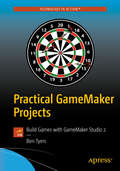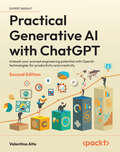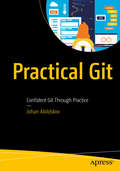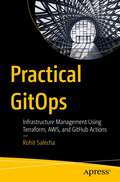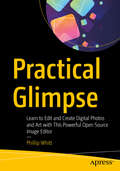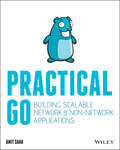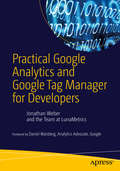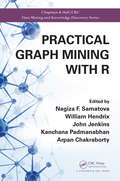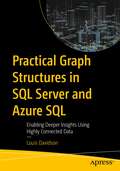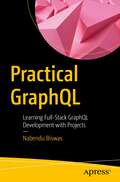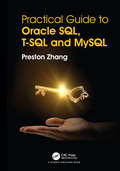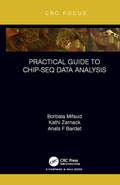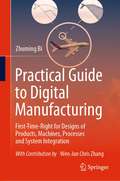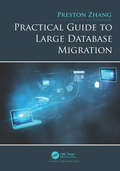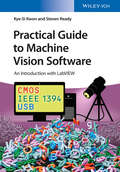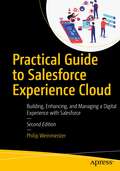- Table View
- List View
Practical GameMaker Projects: Build Games with GameMaker Studio 2
by Ben TyersMake ten simple, casual games, and learn a ton of GML coding along the way. Each of these games is the kind you can play when you have a minute or two free, and are great for playing on your PC, or exported to HTML5 or Android.Each game in Practical GameMaker Projects has its own chapter that explains the process of making each game, along with sketches, screenshots, coding, explanations, and tips. For each game there is a YYZ project file of the completed game that is ready to load and play. Also, all resources are available so you can make the game as you follow along in the book.Each chapter has an introduction that explains what the aim of the game is, followed by a design and coding section which will cover the coding of the game. You’re free to re-use code in your own projects, both free and paid. At the end of each chapter there is a things-to-try page that gives you five things to add to the game to improve its playability or appearance – pushing you a little to improve your planning and GML skills. What You'll LearnBuild ten game applications using GameMaker Studio 2Use the GameMaker Markup Language along the wayMaster the concepts behind each of the ten game apps Design and code for each of the ten game examplesTry some add-ons for each of the ten gamesWho This Book Is ForGame developers with at least some prior game development experience. GameMaker Studio experience recommended, but not required.
Practical GameMaker: Studio
by Ben TyersGain the skills required to create fun and compelling games using GameMaker: Studio, and its GML programming language. In this full-color book you'll learn 24 practical programming elements that are important when creating any game. Each section includes an introduction to a new programming element, some examples, a worksheet, and mini projects to allow you to test your new knowledge. After completing all elements, you will put into action what you have learned in a classic arcade style game. In Practical GameMaker: Studio, you will create a fully featured game, with guidance and in color. After each section you'll see how you'll apply what you've learned to the final game, and discover additional projects to try. These mini projects include a separate scoring guide, and a working example for each, which is useful if you're using this book in an educational environment. Similarly, the book also contains a number of assignments, which you may include as part of any associated coursework in your classes. What You Will Learn Use GameMaker: Studio and GameMaker Language (GML) to create games Work with GML variables, conditionals, drawing, keyport I/O, objects, and events Create GML sprites, health/lives, alarms, collisions, and rooms Improve your game with GML backgrounds, sound and music, splash screens and menus, and effects Include GML random and AI movements in your game Use GML loops, arrays, ds_lists, paths, and scripts Who This Book Is For Experienced game developers new to GameMaker or for those with at least some prior exposure or experience with GameMaker: Studio but who are new to GML.
Practical Generative AI with ChatGPT: Unleash your prompt engineering potential with OpenAI technologies for productivity and creativity
by Valentina AltoTransform your professional world with ChatGPT and OpenAI—master prompt design to revolutionize development, marketing, research, and enterprise implementationKey FeaturesTurn ChatGPT into your companion for marketing, research, personal productivity, art and codingLearn prompt engineering techniques that deliver consistent, relevant, and ethical AI-powered resultsBuild custom GPTs and assistants tailored to your specific business needs and workflowsPurchase of the print or Kindle book includes a free PDF eBookBook DescriptionPractical Generative AI with ChatGPT is your hands-on guide to unlocking the full potential of ChatGPT. From building AI assistants and mastering prompt engineering to analyzing documents and images and even generating code, this book equips you with the skills to integrate generative AI into your workflow. Written by a technical architect specializing in AI and intelligent applications, this book provides the tools and knowledge you need to streamline tasks, enhance productivity, and create intelligent solutions. You’ll learn how to craft precise prompts, leverage ChatGPT for daily efficiency, and develop custom AI assistants tailored to your needs. The chapters show you how to use ChatGPT’s multimodal capabilities to generate images with DALL·E and even transform images into code. This ChatGPT book goes beyond basic interactions by showing you how to design custom GPTs and integrate OpenAI’s APIs into your applications. You’ll explore how businesses use OpenAI models, from building AI applications, including semantic search, to creating an AI roadmap. Each chapter is packed with practical examples, ensuring you can apply the techniques right away. By the end of this book, you’ll be well equipped to leverage OpenAI's technology for competitive advantage.What you will learnExplore the fundamentals of generative AI and GPT modelsMaster prompt engineering to consistently get relevant and reliable outputs from ChatGPTDevelop marketing strategies and conduct meaningful A/B testing with AI assistanceBoost your coding with code generation, review, and optimizationEnhance research with real-time knowledge miningEnhance your visual creativity with image generation, image understanding, and style transferDesign custom GPTs and assistants tailored to specific business functionsDiscover how enterprises are leveraging large language models for their AI appsWho this book is forThis book is ideal for business professionals, developers, marketers, researchers, and decision-makers who want to leverage AI to enhance productivity. No advanced technical background is required for the foundational sections, making the content accessible to beginners, while later chapters provide depth for technical professionals implementing enterprise solutions. If you’re seeking practical applications of generative AI in business contexts, you’ll find immediate, actionable value in this book.
Practical Git: Confident Git Through Practice
by Johan AbildskovPractice your Git skills using exercises in your own environment. This book introduces concepts in an abstract visual way, and then enforces this learning through exercises - the Git katas. You will start with basic interactions such as commits and branches, and move on to both internals and collaborative workflows. Best practices are introduced and rehearsed throughout with hands-on exercises. Each topic is supplemented with interactive Git exercises that can be solved using any Git client – either the ubiquituous CLI or one of the many graphical clients so you'll learn in the environment you work in. The importance of Git is hard to overstate – it is used by 90% of software engineers worldwide and is the de facto standard for version control. Honing your Git skills is guaranteed to make you a better and more efficient developer. Building software can be stressful, but it doesn’t need to be. Practical Git will give you the Git skills you need, and help keep your Git skills sharp. Add it to your library today. What You'll LearnUse Git through scripted exercises and the Git katas Understand Git’s graph modelTroubleshoot common and rare scenarios you may faceSelect and apply the right Git tool for the taskMaintain and collaborate on Git repositoriesTweak Git to gain the most from this powerful tool Who This Book Is For Anyone who is currently using Git in a copy-paste fashion. It will take you from using Git to knowing Git.
Practical GitLab Services: A Complete DevOps Guide for Developers and Administrators
by Jeffrey PainterLearn all about GitLab administration, the open-source DevOps platform helping millions develop and deploy safe and secure software. This book is designed to be your one-stop shop to get up and running with complete ease. Start with the basics like setting up a GitLab account and exploring user options before moving on to GitLab’s primary function as a source code management tool. From there, you’ll learn about one of the most unique features of GitLab: CI/CD configuration files. The next step on the journey is a discussion of how to organize code into projects and groups, along with defining access permissions using roles. You’ll also examine the various planning tools provided by GitLab. With the basic features out of the way, you’ll delve into more specialized services such as the built-in Docker image repository, the package registry, web page creation, and binary file storage. The book concludes with more advanced administrative topics such as working with GitLab’s REST and GraphQL APIs, setting up a proof-of-concept GitLab service using Amazon Web Services (AWS), and spinning up a production service that takes high availability and disaster recovery into account. With an abundance of information available for deploying secure software, selecting the right documentation can often be daunting. From planning to monitoring, Practical GitLab Services eliminates the unknown in your DevOps lifecycle. What You Will Learn Use GitLab to manage source code files, track and plan issues, run builds and tests, and deploy software See how administrators can support developers using GitLab Set up your own standalone installation using AWS Who This Book Is For Software developers, potential GitLab administrators, supporting team members such as testers and project managers.
Practical GitOps: Infrastructure Management Using Terraform, AWS, and GitHub Actions
by Rohit SalechaInfrastructure as Code (IaC) is gaining popularity and developers today are deploying their application environments through IaC tools to the cloud. However, it can become extremely difficult and time-consuming to manage the state of the infrastructure that has been deployed. This book will provide a complete walkthrough of deploying a SpringBoot application on AWS with multiple environments like production, staging and development. Everything is orchestrated through GitHub Actions and executed through Terraform Cloud to monitor changes in your infrastructure and manage its state. You'll start by reviewing how your infrastructure can be stored in code by spinning up an EC2 server first through the console, then AWS CLI and then using Terraform. You'll then be presented with a practical scenario of setting up a simple EC2 server in a multi-environment (production, staging and development) using GitHub Actions and Terraform Cloud. In the advanced section that follows, this simple EC2 server is expanded into an application that is deployed on an AWS EKS (Elastic Kubernetes Service) using AWS RDS (Relational Database Service) exposed through an AWS ALB (Application Load Balancer) protected using AWS ACM (AWS Certificate Manager), and accessible by setting the AWS Route53. The book then builds up on this infrastructure and demonstrates how it can be deployed in a multi-environment scenario by implementing accounts through AWS organizations. You'll see how to put in restrictions through Service Control Policies, how to protect secrets using AWS Secrets Manager, and how to work with least privileges using IRSA (IAM Roles for Service Accounts). Finally, you'll make the infrastructure more observable using Graphana, Prometheus, and AWS OpenSearch, run security tools, host Route53 zones dynamically based on environments, and implement CloudWatch Alarms for various use cases.
Practical Glimpse: Learn to Edit and Create Digital Photos and Art with This Powerful Open Source Image Editor
by Phillip WhittLearn how to edit images and create compelling digital art with Glimpse, the newest open source alternative to Adobe Photoshop and GIMP. This book explores Glimpse's broad selection of tools and features that can create beautiful (raster) digital art; painting, drawings, and art created from photos by applying one of the many filters to create artistic effects. You will quickly become acquainted with this powerful program and understand how to use workspace tools and layers. You will learn step-by-step how to correct exposure, digitally retouch and repair damaged photos, and handle just about any photo editing task—even colorizing grayscale images. Practice files are provided with step-by-step instructions to jump into photo editing and art creation. Glimpse is a powerful program that is a viable alternative to Adobe Photoshop and other proprietary software. The possibilities of the art one can create are almost limitless—get started with it using this book today.What You'll LearnNavigate the Glimpse workspaceUse layers, which are essential in any professional quality image editing programWork with the varied tools that Glimpse offersEnhance, retouch, and modify digital imagesRestore and repair damaged family photos, and create composites such as replacing backgroundsCreate compelling digital artwork using the drawing tools and by applying artistic filtersWho This Book Is For Anyone desiring to learn serious image editing with Glimpse. It can be used by both fledgling and professional photographers, freelance graphic designers, students, genealogists, and more. Because it’s free, it can be especially advantageous to teachers, students, and small business owners on a budget.
Practical Go: Building Scalable Network and Non-Network Applications
by Amit SahaStep-by-step instruction on writing your first production-ready servers with Golang Google's Go language, otherwise known as Golang, is a fast, simple, and reliable language that is rapidly becoming a highly popular choice for developers of all kinds. With particular utility in cloud-native environments, Golang is being adopted in major projects like Docker and Ethereum thanks to its user-friendly features, like concurrency and easy deployment. In Practical Golang: Building Scalable Network and Non-Network Applications, expert coder and devops engineer Amit Saha delivers a step-by-step guide to writing production-ready HTTP 1.1, HTTP2, RPC, and TCP/UDP servers. Walking you through the entire process of learning this already straightforward language, from your first application to your first deployed server, the authors rely solely on the most popular open-source projects to ensure you can apply the book's advice in any cloud environment. In this book, you'll get: Fulsome descriptions of best practices on load balancing, scaling, and failure handling Stepwise guidance on writing an HTTP service from scratch using only Golang's standard library Easy tutorials on implementing RPC and HTTP interfaces for RPC services Straightforward instructions on using SQL databases Perfect for software developers, devops engineers, and other programming professionals, Practical Golang is also an indispensable resource for anyone who wants to go beyond the basics of Golang and deploy robust and practical servers.
Practical Google Analytics and Google Tag Manager for Developers
by Jonathan WeberWhether you're a marketer with development skills or a full-on web developer/analyst, Practical Google Analytics and Google Tag Manager for Developers shows you how to implement Google Analytics using Google Tag Manager to jumpstart your web analytics measurement. There's a reason that so many organizations use Google Analytics. Effective collection of data with Google Analytics can reduce customer acquisition costs, provide priceless feedback on new product initiatives, and offer insights that will grow a customer or client base. So where does Google Tag Manager fit in? Google Tag Manager allows for unprecedented collaboration between marketing and technical teams, lightning fast updates to your site, and standardization of the most common tags for on-site tracking and marketing efforts. To achieve the rich data you're really after to better serve your users' needs, you'll need the tools Google Tag Manager provides for a best-in-class implementation of Google Analytics measurement on your site. Written by data evangelist and Google Analytics expert Jonathan Weber and the team at LunaMetrics, this book offers foundational knowledge, a collection of practical Google Tag Manager recipes, well-tested best practices, and troubleshooting tips to get your implementation in tip-top condition. It covers topics including: * Google Analytics implementation via Google Tag Manager * How to customize Google Analytics for your unique situation * Using Google Tag Manager to track and analyze interactions across multiple devices and touch points * How to extract data from Google Analytics and use Google BigQuery to analyze Big Data questions What you'll learn Implementation approaches for Google Analytics, including common pitfalls and troubleshooting strategies. How to use tools like Google Tag Manager and jQuery to jumpstart your Google Analytics implementation. How to track metrics beyond page views to other critical user interactions, such as clicks on outbound links or downloads, scrolling and page engagement, usage of AJAX forms, and much more. How to incorporate additional, customized data into Google Analytics to track individual users or enrich data about their behavior. Who this book is for Web developers, data analysts, and marketers with a basic familiarity with Google Analytics from an end-user perspective, as well as some knowledge of HTML and JavaScript. Table of Contents Google Analytics Fundamentals Basic Google Analytics Measurement Introducing Google Tag Manager (GTM) Testing Your Implementation Tracking Interactions using Google Tag Manager Goals: Measuring Conversions Ecommerce: Tracking Products and Purchases Cleaning Up and Enriching Data Measuring Campaigns and Troubleshooting Traffic Sources Tracking Users Across Devices Providing Additional Data about your Users GA's Measurement Protocol: Collecting data from anywhere Collecting Data from Mobile Apps with GA & GTM Importing Data into GA Using GA with BigQuery for Big Data analysis Appendix: Google Tag Manager and Google APIs
Practical Graph Analytics with Apache Giraph
by Claudio Martella Roman Shaposhnik Dionysios LogothetisPractical Graph Analytics with Apache Giraph helps you build data mining and machine learning applications using the Apache Foundation's Giraph framework for graph processing. This is the same framework as used by Facebook, Google, and other social media analytics operations to derive business value from vast amounts of interconnected data points. Graphs arise in a wealth of data scenarios and describe the connections that are naturally formed in both digital and real worlds. Examples of such connections abound in online social networks such as Facebook and Twitter, among users who rate movies from services like Netflix and Amazon Prime, and are useful even in the context of biological networks for scientific research. Whether in the context of business or science, viewing data as connected adds value by increasing the amount of information available to be drawn from that data and put to use in generating new revenue or scientific opportunities. Apache Giraph offers a simple yet flexible programming model targeted to graph algorithms and designed to scale easily to accommodate massive amounts of data. Originally developed at Yahoo!, Giraph is now a top top-level project at the Apache Foundation, and it enlists contributors from companies such as Facebook, LinkedIn, and Twitter. Practical Graph Analytics with Apache Giraph brings the power of Apache Giraph to you, showing how to harness the power of graph processing for your own data by building sophisticated graph analytics applications using the very same framework that is relied upon by some of the largest players in the industry today. What you'll learn Model relationships in your data as graphs Learn the Apache Giraph programming model and API Create data mining algorithms in the Apache Giraph framework Recognize common programming patterns in graph analysis Scale your analyses applications as your business grows Integrate your use of Giraph with Hadoop and other elements of the Big Data ecosystem Who this book is for Practical Graph Analytics with Apache Giraph is for data scientists and developers wanting to build large-scale, graph-mining and machine-learning applications. Practical Graph Analytics with Apache Giraph can also serve as guide for architects who want to integrate such analytics applications into their infrastructure. Table of Contents Part I: Giraph Building Blocks 1. Introduction to Graphs and Giraph 2. Modeling Graph Processing Use Cases 3. The Giraph Programming Model 4. Giraph Algorithmic Building Blocks Part II: Giraph Overview 5. Working with Giraph 6. Giraph Architecture 7. Graph I/O Formats 8. Beyond the Basic API Part III: Advanced Topics 9. Exposing Parallelism in Giraph 10. Beyond HDFS 11. Giraph Tuning 12. Giraph in the Cloud
Practical Graph Mining with R (Chapman & Hall/CRC Data Mining and Knowledge Discovery Series)
by John Jenkins Nagiza F. Samatova Arpan Chakraborty William Hendrix Kanchana PadmanabhanDiscover Novel and Insightful Knowledge from Data Represented as a GraphPractical Graph Mining with R presents a "do-it-yourself" approach to extracting interesting patterns from graph data. It covers many basic and advanced techniques for the identification of anomalous or frequently recurring patterns in a graph, the discovery of groups or cluste
Practical Graph Structures in SQL Server and Azure SQL: Enabling Deeper Insights Using Highly Connected Data
by Louis DavidsonUse the graph table features in Azure SQL that were introduced in SQL Server 2017 and further refined in SQL Server 2019. This book shows you how to create data structures to capture complex connections between items in your data. These connections will help you analyze and draw insights from connections in your data that go beyond classic relationships. The graph examples in the book are useful for analyzing social media relationships, complex product-to-customer relationships, and any other type of data analysis in which indirect connections that otherwise might be missed using conventional techniques can be mined for their insight and business value. Tree structures are covered, with emphasis on a structure commonly used by organizations to aggregate data at different levels of an organization. The book provides code examples of SQL Graph objects as well as an alternate tree implementation technique. Included is sample data (and data generators) for you to test for performance and choose the implementation approach that best suits your needs and that of your application.If your job involves analyzing or storage of data elements that are connected in a networked topology, then this is the book that will help you bring the power of SQL Server to bear on that data and take advantage of your existing knowledge. What You Will LearnUnderstand the graph model and the associated terms used in graph analysisStore highly connected data in SQL Server and Azure SQL alongside existing relational dataMake full use of the graph table feature that is refined and enhanced in SQL Server 2019Implement high performance tree structures that will make storing and querying tree data possibleReport on data associated with a tree structure to aggregate results at different levelsWho This Book Is For
Practical GraphQL: Learning Full-Stack GraphQL Development with Projects
by Nabendu BiswasMaster the query language that is revolutionizing how websites are developed and built. This book is a hands-on guide to GraphQL, and will teach you how to use this open source tool to develop and deploy applications quickly and with minimal fuss.Using a project-based approach, you'll learn how to use GraphQL from the ground up. You'll start with the basics, including set up and key details regarding queries and mutations, before moving on to more advanced topics and projects. Over the course of the book, you will gain a thorough understanding of the web development ecosystem from frontend to backend by building React applications using Prisma Apollo Client and MongoDB.After completing this book, you'll be equipped with the knowledge and skills needed to turbo charge your own enterprise projects.What You'll LearnUnderstand what GraphQL is and how to use itDistinguish between queries and mutations, and how to leverage themGain a greater knowledge of full-stack applications with React, Apollo Server, and Apollo ClientCreate a full stack application with React and PrismaWho This Book Is ForDevelopers and engineers who want to learn about GraphQL so that they can implement in their enterprise React projects. This book is aimed at both backend developers and full stack developers who want to learn to create backend queries using GraphQL.
Practical Guide for Oracle SQL, T-SQL and MySQL
by Preston ZhangSQL is a widely used to access most databases, therefore database developers and system administrators should be familiar with it. This hands-on SQL book will help beginner and intermediate users to write queries that apply complex conditions on a table. The book's unique side by side approach makes it easy for the reader to learn three major query languages in the IT industry. The author has over 20 years of experience in database design. KEY FEATURES: Contains numerous practical screenshots of Oracle SQL, T-SQL, MySQL statements and results. Shows the differences between Oracle SQL, T-SQL and MySQL side by side. Gives a real world experience for SQL developers and database administrators. Sample data is available to work on (available on our website).
Practical Guide to Applied Conformal Prediction in Python: Learn and apply the best uncertainty frameworks to your industry applications
by Valery ManokhinElevate your machine learning skills using the Conformal Prediction framework for uncertainty quantification. Dive into unique strategies, overcome real-world challenges, and become confident and precise with forecasting.Key FeaturesMaster Conformal Prediction, a fast-growing ML framework, with Python applicationsExplore cutting-edge methods to measure and manage uncertainty in industry applicationsUnderstand how Conformal Prediction differs from traditional machine learningBook DescriptionIn the rapidly evolving landscape of machine learning, the ability to accurately quantify uncertainty is pivotal. The book addresses this need by offering an in-depth exploration of Conformal Prediction, a cutting-edge framework to manage uncertainty in various ML applications. Learn how Conformal Prediction excels in calibrating classification models, produces well-calibrated prediction intervals for regression, and resolves challenges in time series forecasting and imbalanced data. Discover specialised applications of conformal prediction in cutting-edge domains like computer vision and NLP. Each chapter delves into specific aspects, offering hands-on insights and best practices for enhancing prediction reliability. The book concludes with a focus on multi-class classification nuances, providing expert-level proficiency to seamlessly integrate Conformal Prediction into diverse industries. With practical examples in Python using real-world datasets, expert insights, and open-source library applications, you will gain a solid understanding of this modern framework for uncertainty quantification. By the end of this book, you will be able to master Conformal Prediction in Python with a blend of theory and practical application, enabling you to confidently apply this powerful framework to quantify uncertainty in diverse fields.What you will learnThe fundamental concepts and principles of conformal predictionLearn how conformal prediction differs from traditional ML methodsApply real-world examples to your own industry applicationsExplore advanced topics - imbalanced data and multi-class CPDive into the details of the conformal prediction frameworkBoost your career as a data scientist, ML engineer, or researcherLearn to apply conformal prediction to forecasting and NLPWho this book is forIdeal for readers with a basic understanding of machine learning concepts and Python programming, this book caters to data scientists, ML engineers, academics, and anyone keen on advancing their skills in uncertainty quantification in ML.
Practical Guide to ChIP-seq Data Analysis (Focus Computational Biology Series)
by Borbala Mifsud Kathi Zarnack Anaïs F BardetChromatin immunoprecipitation sequencing (ChIP-seq), which maps the genome-wide localization patterns of transcription factors and epigenetic marks, is among the most widely used methods in molecular biology. Practical Guide to ChIP-seq Data Analysis will guide readers through the steps of ChIP-seq analysis: from quality control, through peak calling, to downstream analyses. It will help experimental biologists to design their ChIP-seq experiments with the analysis in mind, and to perform the basic analysis steps themselves. It also aims to support bioinformaticians to understand how the data is generated, what the sources of biases are, and which methods are appropriate for different analyses.
Practical Guide to Clinical Data Management
by Susanne ProkschaThe management of clinical data, from its collection during a trial to its extraction for analysis, has become critical in preparing a regulatory submission and obtaining approval to market a treatment. Groundbreaking on its initial publication nearly 14 years ago, and evolving with the field in each iteration since then, this latest volume includes revisions to all chapters to reflect the recent updates to ICH E6, good clinical practices, electronic data capture, and interactive response technologies. Keeping the coverage practical, the author focuses on the most critical information that impacts clinical trial conduct, providing a full end-to-end overview for clinical data managers.Features: Provides an introduction and background information for the spectrum of clinical data management tasks. Outstanding text in the industry and has been used by the Society for Clinical Data Management in creating its certification exam. Explains the high-level flow of a clinical trial from creation of the protocol through study lock. Reflects electronic data capture and interactive response technologies. Discusses using the concept of three phases in the clinical data management of a study: study startup, study conduct, and study closeout, to write procedures and train staff.
Practical Guide to Digital Manufacturing: First-Time-Right for Design of Products, Machines, Processes and System Integration
by Zhuming BiThis book covers the subject of digital manufacturing. It provides a practical guide for readers on using computer aided design (CAD), computer aided engineering (CAE) and computer aided manufacturing (CAM) and other computer assistive tools for the design of products, machines, processes and system integrations through the case studies of engineering projects. The book introduces a thorough theoretical foundation and discussion of the historical development, and enabling technologies of digital manufacturing. It also covers a broad range of computer aided tools for a variety of applications including: geometric modelling;assembly modelling;motion simulation;finite element analysis;manufacturing process simulation;machining programming;product data management; and,product lifecycle management. Practical Guide to Digital Manufacturing uses many real-world case studies to illustrate the discussed applications, making it easily readable for undergraduate and graduate students, as well as engineers with the needs of computer-aided design and manufacturing knowledge and skills.
Practical Guide to IT Problem Management (IT Pro Practice Notes)
by Andrew DixonSome IT organisations seem to expend all their energy firefighting – dealing with incidents as they arise and fixing, or patching over, the breakage. In organisations like this, restarting computers is seen as a standard method to resolve many issues. Perhaps the best way to identify whether an organisation understands problem management is to ask what they do after they have restarted the computer. If restarting the computer fixes the issue, it is very tempting to say that the incident is over and the job is done. Problem management recognises that things do not improve if such an approach is taken. Such organisations are essentially spending their time running to stay in the same place. Written to help IT organisations move forward, Practical Guide to IT Problem Management presents a combination of methodologies including understanding timelines and failure modes, drill down, 5 whys and divide and conquer. The book also presents an exploration of complexity theory and how automation can assist in the desire to shift left both the complexity of the problem and who can resolve it. The book emphasises that establishing the root cause of a problem is not the end of the process as the resolution options need to be evaluated and then prioritised alongside other improvements. It also explores the role of problem boards and checklists as well as the relationship between problem management and Lean thinking. This practical guide provides both a framework for tackling problems and a toolbox from which to select the right methodology once the type of problem being faced has been identified. In addition to reactive methods, it presents proactive activities designed to reduce the incidence of problems or to reduce their impact and complexity should they arise. Solving problems is often a combination of common sense and methodologies which may either be learnt the hard way or may be taught. This practical guide shows how to use problem solving tools and to understand how and when to apply them while upskilling IT staff and improving IT problem solving processes.
Practical Guide to Large Database Migration
by Preston ZhangIt is a major challenge to migrate very large databases from one system, say for example, to transfer critical data from Oracle to SQL Server. One has to consider several issues such as loss of data being transferred, the security of the data, the cost and effort, technical aspects of the software involved, etc. There a very few books that provide practical tools and the methodology to migrate data from one vendor to another. This book introduces the concepts in database migration with large sample databases. It provides step by step guides and screenshots for database migration tools. Many examples are shown for migrating Oracle, SQL Server and MySQL databases.
Practical Guide to Life Science Databases
by Imad Abugessaisa Takeya KasukawaThis book provides the latest information of life science databases that center in the life science research and drive the development of the field. It introduces the fundamental principles, rationales and methodologies of creating and updating life science databases. The book brings together expertise and renowned researchers in the field of life science databases and brings their experience and tools at the fingertips of the researcher. The book takes bottom-up approach to explain the structure, content and the usability of life science database. Detailed explanation of the content, structure, query and data retrieval are discussed to provide practical use of life science database and to enable the reader to use database and provided tools in practice. The readers will learn the necessary knowledge about the untapped opportunities available in life science databases and how it could be used so as to advance basic research and applied research findings and transforming them to the benefit of human life.Chapter 2 is available open access under a Creative Commons Attribution 4.0 International License via link.springer.com.
Practical Guide to Machine Learning, NLP, and Generative AI: Libraries, Algorithms, and Applications (River Publishers Series in Rapids in Computing and Information Science and Technology)
by T. Mariprasath Kumar Reddy Cheepati Marco RiveraThis is an essential resource for beginners and experienced practitioners in machine learning. This comprehensive guide covers a broad spectrum of machine learning topics, starting with an in-depth exploration of popular machine learning libraries. Readers will gain a thorough understanding of Scikit-learn, TensorFlow, PyTorch, Keras, and other pivotal libraries like XGBoost, LightGBM, and CatBoost, which are integral for efficient model development and deployment.The book delves into various neural network architectures, providing readers with a solid foundation in understanding and applying these models. Beginning with the basics of the Perceptron and its application in digit classification, it progresses to more complex structures such as multilayer perceptrons for financial forecasting, radial basis function networks for air quality prediction, and convolutional neural networks (CNNs) for image classification. Additionally, the book covers recurrent neural networks (RNNs) and their variants like long short-term memory (LSTM) and gated recurrent units (GRUs), which are crucial for time-series analysis and sequential data applications.Supervised machine learning algorithms are meticulously explained, with practical examples to illustrate their application. The book covers logistic regression and its use in predicting sports outcomes, decision trees for plant classification, random forests for traffic prediction, and support vector machines for house price prediction. Gradient boosting machines and their applications in genomics, AdaBoost for bioinformatics data classification, and extreme gradient boosting (XGBoost) for churn prediction are also discussed, providing readers with a robust toolkit for various predictive tasks.Unsupervised learning algorithms are another significant focus of the book, introducing readers to techniques for uncovering hidden patterns in data. Hierarchical clustering for gene expression data analysis, principal component analysis (PCA) for climate predictions, and singular value decomposition (SVD) for signal denoising are thoroughly explained. The book also explores applications like robot navigation and network security, demonstrating the versatility of these techniques.Natural language processing (NLP) is comprehensively covered, highlighting its fundamental concepts and various applications. The book discusses the overview of NLP, its fundamental concepts, and its diverse applications such as chatbots, virtual assistants, clinical NLP applications, and social media analytics. Detailed sections on text pre-processing, syntactic analysis, machine translation, text classification, named entity recognition, and sentiment analysis equip readers with the knowledge to build sophisticated NLP models.The final chapters of the book explore generative AI, including generative adversarial networks (GANs) for image generation, variational autoencoders for vibrational encoder training, and autoregressive models for time series forecasting. It also delves into Markov chain models for text generation, Boltzmann machines for pattern recognition, and deep belief networks for financial forecasting. Special attention is given to the application of recurrent neural networks (RNNs) for generation tasks, such as wind power plant predictions and battery range prediction, showcasing the practical implementations of generative AI in various fields.
Practical Guide to Machine Vision Software
by Kye-Si Kwon Steven ReadyFor both students and engineers in R&D, this book explains machine vision in a concise, hands-on way, using the Vision Development Module of the LabView software by National Instruments. Following a short introduction to the basics of machine vision and the technical procedures of image acquisition, the book goes on to guide readers in the use of the various software functions of LabView's machine vision module. It covers typical machine vision tasks, including particle analysis, edge detection, pattern and shape matching, dimension measurements as well as optical character recognition, enabling readers to quickly and efficiently use these functions for their own machine vision applications. A discussion of the concepts involved in programming the Vision Development Module rounds off the book, while example problems and exercises are included for training purposes as well as to further explain the concept of machine vision.With its step-by-step guide and clear structure, this is an essential reference for beginners and experienced researchers alike.
Practical Guide to Salesforce Communities: Building, Enhancing, and Managing an Online Community with Salesforce Community Cloud
by Philip WeinmeisterWhether you are brand new to the world of Salesforce communities or you are looking to take your Community Cloud knowledge to the next level, this detailed guide will help you to build and manage a Salesforce community by leveraging the declarative power of the platform with clicks, not code.Each Salesforce community is a part of a widespread ecosystem, with thousands of communities and millions of users active today on Community Cloud. Through valuable social and business tools, this online platform enables companies to empower and equip their customers, partners, and employees in new, powerful ways. In this book, Philip Weinmeister, a Salesforce MVP and the first-ever recipient of the “Community Cloud MVP” Trailblazer award, leads you through the ins and outs of Salesforce communities and provides you with an array of best practices to deliver top-notch business portals on the Salesforce platform.Practical Guide to Salesforce Communities is the first book to comprehensively cover this next-generation offering from Salesforce, providing real, actionable guidance to help individuals build effective and engaging online communities. The book takes you through the entire process: from planning and designing a community to configuration/build, setup, and administration, all the way to deployment. Detailed explanations are provided of key components, templates, and features such as Community Builder, Audience Targeting, Lightning Bolts, and much more. Additionally, considerations and best practices are covered, including valuable tips and insights.What You’ll Learn Plan and design a communityConceptualize how employees, partners, and customers use and benefit from communitiesAssess available templates and make an informed selection decisionUse Community Builder and Lightning components within a Lightning community templateApply topics and knowledge articles to a community to increase value and adoptionInject process automation into a community using Workflow, Flow, and Process BuilderCreate dynamic and personalized user experiences with audience targetingBuild, export, and import unique templates with the Lightning Bolt solution frameworkProvide community data for members or community managers Who This Book Is For Salesforce administrators, Salesforce developers, Salesforce functional architects, Salesforce business analysts, and Salesforce community managers
Practical Guide to Salesforce Experience Cloud: Building, Enhancing, and Managing a Digital Experience with Salesforce
by Philip WeinmeisterWhether you are brand new to the world of digital experiences on the Salesforce platform or you are looking to take your Experience Cloud (previously "Community Cloud") knowledge to the next level, this detailed guide will help you build and manage a Salesforce site by leveraging the declarative power of the platform with clicks, not code.Each Salesforce site/community is a part of a widespread ecosystem, with thousands of sites and millions of users active today on Experience Cloud. Through valuable social and business tools, this online platform enables companies to empower and equip their customers, partners, and employees in new, powerful ways.Author Philip Weinmeister, Salesforce MVP and the only recipient of the “Community Cloud MVP” Trailblazer award from Salesforce, leads you through the ins and outs of Salesforce Experience Cloud and provides you with an array of best practices to deliver top-notch business portals on the Salesforce platform.This completely revised edition updates all content to reflect the new "experience-centric" branding and a slew of platform updates from the last few years (including screenshots, terminology, features, etc.). Net new content includes Salesforce CMS, the Experience Cloud Consultant certification exam, and Mobile Publisher, among other topics.The book takes you through the entire process: from planning and designing a site to configuration/build, setup, and administration, all the way to deployment. Detailed explanations are provided for key components, templates, and features such as Experience Builder, Audience Targeting, Lightning Bolts, and much more.What You Will LearnPlan and design a site using Experience CloudConceptualize how employees, partners, and customers use and benefit from Salesforce sitesUse Experience Builder and Lightning components within an Experience Builder templateApply topics and knowledge articles to a site to increase value and adoptionBuild and display rich content within a site using Salesforce CMSCreate dynamic and personalized user experiences with audience targetingBuild, export, and import unique templates with the Lightning Bolt solution frameworkProvide site data for members or site managersWho This Book Is ForSalesforce administrators, developers, functional architects, business analysts, and site/community managers.
